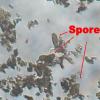
12-12-2025 18:39
Mirek GrycHello everyone.Macrofeatures similar to Mollisia b

09-12-2025 12:06
 Andgelo Mombert
Andgelo Mombert
Bonjour,Je recherche l'article concernant Hypobryo

07-12-2025 16:07
Arnold BüschlenHallo, ich habe in einer Moos-Aufsammlung (epiphy

08-12-2025 21:04
Mark Stevens"Hello everyone,I'm relatively new to microscopy (

08-12-2025 18:59
 Lothar Krieglsteiner
Lothar Krieglsteiner
.. found by a seminar-participant, I do not know t

08-12-2025 17:37
 Lothar Krieglsteiner
Lothar Krieglsteiner
20.6.25, on branch of Abies infected and thickened
Hypoxylon multiforme?
VASILEIOS KAOUNAS,
19-09-2008 07:22
Spores 10,2-11,6*4,2-5,2 ìm, Q=2,2-2,6
Christian Lechat,
19-09-2008 08:33

Re:Hypoxylon multiforme?
Difficult to say with so few elements, but it looks like H. cohaerens.
Regards,
Regards,
Jacques Fournier,
19-09-2008 08:48

Re:Hypoxylon multiforme?
Hi Vasileios,
H. cohaerens is specific for Fagus. Otherwise its main difference with H multiforme is the germ slit length on ascospores: short in multiforme, spore-length in cohaerens, best seen in KOH.
You can visit http://pyrenomycetes.free.fr/ for more informations.
Best wishes,
Jacques
H. cohaerens is specific for Fagus. Otherwise its main difference with H multiforme is the germ slit length on ascospores: short in multiforme, spore-length in cohaerens, best seen in KOH.
You can visit http://pyrenomycetes.free.fr/ for more informations.
Best wishes,
Jacques
VASILEIOS KAOUNAS,
19-09-2008 08:52
Re:Hypoxylon multiforme?
Thank you very much for your correspondence
Andrew N. Miller,
19-09-2008 18:08

Re:Hypoxylon multiforme?
I believe both H. multiforme and H. cohaerens (along with H. truncatum and H. annulatum) have all been transferred to the new genus, Annulohypoxylon by Y.-M. Ju, J.D. Rogers & H.-
M. Hsieh.
Andy
M. Hsieh.
Andy
Jacques Fournier,
19-09-2008 18:48

Re:Hypoxylon multiforme?
Hi Andy,
you are perfectly right as to the new name Annulohypoxylon but I told Vasileios to visit my website, which has not been updated since this change....names change but fortunately fungi do not much ..
Jacques
you are perfectly right as to the new name Annulohypoxylon but I told Vasileios to visit my website, which has not been updated since this change....names change but fortunately fungi do not much ..
Jacques

